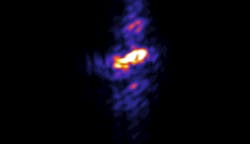Attosecond Rabi cycling and filamentation within inner-shell x-ray lasing
Ultrafast lasers are essential to a multitude of science and industrial applications ranging from semiconductor lithography to fundamental studies of atoms and electrons. Their pulses are often generated through using nonlinear interactions of pump lasers with a gain medium that can result in pulses with durations on the attosecond (10-18) timescale, or one billionth of a billionth of a second—timescales needed for studying the fastest processes in nature.
Our recent paper, published in the journal Nature, reports the observation of two hallmark nonlinear optical phenomena: Rabi cycling and filamentation, not in optical light but at hard x-rays with angstrom (0.1-nm) wavelengths. These effects, known within microwave to visible light laser systems, have now been observed within the x-ray regime during stimulated emission of copper (Cu) and manganese (Mn) inner-shell transitions pumped with highly intense x-ray free-electron laser (XFEL) pulses at the Linac Coherent Light Source (LCLS) at SLAC National Accelerator Laboratory in the U.S. and the SPring-8 angstrom Compact Free Electron Laser (SACLA) in Japan. The researchers find that these effects can lead to the generation of x-ray pulses with durations shorter than 100 attoseconds. What was created was the first attosecond atomic x-ray laser and the shortest hard x-ray pulses to date.
This research demonstrates how traditional nonlinear methods used at optical wavelengths can be extended to 3,000x shorter x-ray wavelengths, opening possibilities for new attosecond x-ray research with atomic spatial resolution. The resulting pulses can lead to several potential applications, from quantum x-ray optics to visualizing electron motion inside molecules.
A surprise result
The observation of both strong lasing phenomena was not the original goal of the work with the experimental team first studying how to use stimulated x-ray emission for chemical speciation of transition metal compounds like manganese. While investigating these samples, the researchers saw multiple hotspots and random spurting in the stimulated emission, where a narrow signal was expected.
When increasing the XFEL intensity, the team started to observe additional large spectral broadening and peak splitting, much larger than possible based on their knowledge of Mn and Cu inner-shell transitions. It took them several years to identify and verify their findings. A breakthrough occurred when a recently developed three-dimensional (3D) simulation was coded to simulate the experimental conditions, rigorously showing the causes of the observed spectra.
Rabi cycling: Coherent population oscillations in core levels
Through the 3D simulations, the researchers were able to understand that the large spectral broadening and peak splitting was a result of Rabi cycling. Rabi cycling refers to the coherent oscillation of atomic populations between a lower energy level and an upper level when driven by a strong, resonant electromagnetic field. The first observation of Rabi cycling was not with lasers but with microwave radiation, 70 years ago when Stanley Autler and Charles Townes observed the splitting of the ammonia inversion line from coherent population transfer.
In the new experiments, the team observed the same spectral splitting but now with x-rays with one hundred million times shorter angstrom wavelengths. They found that the extracted Rabi frequencies from the observed spectral splitting corresponded to attosecond periods. Unlike most studies of Rabi cycling, which drive population dynamics between electronic states near the highest occupied orbitals of atoms or molecules, they were able to drive attosecond coherent population transfer between the innermost orbitals of the Mn and Cu atoms, with the driving resonance being the 2p-1s orbital (Kα) transition. Through detailed comparison with simulations, they discovered that this process would lead to x-ray pulses as short as 60 to 100 attoseconds and generate the observed spectra with widths greater than 20 eV.
Filamentation: Spatial beam modulation via nonlinear gain dynamics
Filamentation generally refers to the breakup of a beam into high-intensity channels during propagation through a nonlinear medium. For visible light systems, this is driven by self-focusing via the Kerr effect (in which the refractive index modulation leads to beam collapse and filament formation). At x-ray wavelengths, the real part of the refractive index is nearly unity and Kerr effects are negligible.
With their 3D code, the researchers were able to understand that their observed filaments resulted from gain-guided spatial instabilities driven by a balance of spontaneous emission, gain driven self-focusing, and 3D propagation. Filamentation occurs at slightly lower pump pulse intensities than Rabi cycling, which leads to much smaller spectral broadening and pulses as short as ~600 attoseconds.
Simulation of generated x-ray light propagating through sample self-focusing and then filamenting. Credit: Thomas Linker/SLAC National Accelerator Laboratory
Implications and future directions
The realization of Rabi cycling and filamentation at hard x-ray wavelengths opens new experimental capabilities primarily centered around development of new x-ray quantum optics techniques. Rabi cycling is the building block for coherent control of quantum systems that is essential for many scientific and industrial applications—ranging from atomic clocks to quantum information technologies. Understanding and controlling the spatial filamentation process along with inner-shell atomic populations will be essential for novel x-ray source development and new coherent x-ray spectroscopies.
Improvements in pump pulses are currently underway at XFEL facilities. In the present work, XFEL pulses consisting of many temporal and spectral spikes were used, and often only the first strong temporal spike was responsible for the Rabi cycling and filamentation. Upgrades to single-spike pulses, improvements in shot stability, repetition rate, and spectral/temporal quality, which are currently underway, will enable experiments with enhanced control of strong-field and coherent nonlinear x-ray dynamic.
FURTHER READING
T. M. Linker et al., Nature, 642, 934–940 (2025); https://doi.org/10.1038/s41586-025-09105-9.
About the Author
Thomas Linker
Thomas Linker is an associate scientist at the Linac Coherent Light Source (LCLS) at SLAC National Accelerator Laboratory. At the time of the research, he was a joint postdoctoral researcher at University of Wisconsin–Madison and SLAC.
Uwe Bergmann
Uwe Bergmann is a physics professor at University of Wisconsin–Madison and visiting faculty at SLAC National Accelerator Laboratory.

